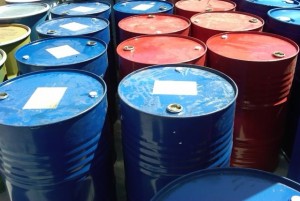 West Texas Intermediate crude extended losses on Wednesday after the Energy Information Administration reported a seventh consecutive weekly gain in nationwide crude inventories and an increase in distillate stockpiles. Losses however were limited as supplies at Cushing, Oklahoma, fell for a fifth straight week. Receding fears of a military campaign in eastern Ukraine kept the oil market pressured after prices spiked on Monday.
West Texas Intermediate crude extended losses on Wednesday after the Energy Information Administration reported a seventh consecutive weekly gain in nationwide crude inventories and an increase in distillate stockpiles. Losses however were limited as supplies at Cushing, Oklahoma, fell for a fifth straight week. Receding fears of a military campaign in eastern Ukraine kept the oil market pressured after prices spiked on Monday.
On the New York Mercantile Exchange, WTI crude for delivery in April traded at $102.16 per barrel at 15:47 GMT, down 1.13% on the day. Prices shifted in a daily range between days high and low of $103.53 and $102.11 a barrel. The US benchmark lost 1.5% on Tuesday, the most in two months, after jumping by the most in three months in the previous day. Prices touched a 5-1/2-month high of $105.22 on Monday.
Meanwhile on the ICE, Brent futures for settlement in the same month slid by 0.85% to trade at $108.38 a barrel after varying in a range between days high and low of $109.37 and $108.22 a barrel. The European benchmark lost 1.7% on Tuesday after it added nearly 2% on Monday and hit a 2-month high of $112.39 a barrel. Brent’s premium to its US counterpart narrowed for a sixth day to $5.97 yesterday, down from $6.28 on Monday, based on closing prices.
Oil prices remained on the downside on Wednesday after the Energy Information Administration reported a seventh consecutive weekly gain in US crude oil inventories. Supplies rose by 1.4 million barrels in the seven days through February 28th, underperforming analysts expectations for a 1.3-million gain, according to a Bloomberg News survey. At 363.8 million barrels, U.S. crude oil inventories are in the middle of the average range for this time of year.
Domestic crude production in the US jumped to 8.08 million barrels per day, the EIA said, remaining close to a the 25-year high of 8.16 million bpd which was registered in the week ended January 10th.
Losses however remained in check as stockpiles at Cushing, Oklahoma, the biggest US storage hub and delivery point for NYMEX-traded contracts, registered a fifth straight weekly decline and fell to a two-year low of 32.1 million barrels from 34.8 million a week earlier.
The Energy Information Administration also reported that refineries operated at 87.4% of their operable capacity last week, down 0.6% from the preceding period. Motor gasoline production increased in the seven days to February 28th, while distillate fuel output decreased, averaging 9.0 million and 4.6 million barrels per day, respectively.
Distillate fuel inventories, which include diesel and heating oil, rose by 1.4 million barrels, the government agency reported, defying analysts expectations for a drop by 1 million, but remained below the lower limit of the average range for this time of year. Total motor gasoline reserves slid by 1.6 million barrels, outperforming forecasts for a 1-million decline, but are above the upper half of the average range.
Oil prices gave up most of their previous gains on Tuesday as fears eased that tension in the Crimea region could lead to a war. President Vladimir Putin recalled troops engaged in military drills near the Ukrainian border, saying he does not see any immediate necessity to invade eastern Ukraine.
However, although Putin said that he would use force as a last resort, the reduced, but persisting probability of another escalation of tension kept the energy complex underpinned as Russian forces remained amassed near the border. Europe relies for a third of its natural gas consumption on Russian deliveries and such a shortage could force a switch to alternative energy sources.
Meanwhile, the oil market drew support after China’s Premier Li Keqiang said at the annual meeting of the National People’s Congress that the Asian economy’s growth target for 2014 remains unchanged from the previous year at 7.5%, while consumer inflation should be reined at about 3.5%.
“China’s growth target may not be double digit, but a stable growth gives assurance to investors that a hard landing is unlikely to happen,” said Chee Tat Tan,an investment analyst at Phillip Futures in Singapore, cited by CNBC.





